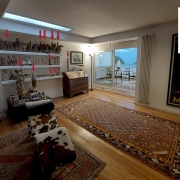2022年 12 月 29 日 " 亞洲藝術品拍賣 "
Ceramic figure 'Horse' with Sancai glaze, Tang dynasty (618 - 906)
A figure modelled in kaolin ware and decorated in amber, green and cream-coloured 'sancai' glaze (三彩). The body of the animal is hollow and has an opening in the lower part of the belly.
It depicts a standing horse with a realistic-looking head cocked to one side and all four legs standing firmly on a rectangular pedestal. The body is robustly built and the neck is muscular. The mane and tail are marked by a hole in which natural materials would have been inserted to simulate the horse's mane, but are not preserved because they are perishable.
An empty saddle decorated with three 'sancai' colours is modelled around the back. At the time of the second firing, the applied glaze slips and mixes randomly, forming unique decorative patterns. The saddle indicates a domesticated animal. Horses were domesticated long before the Tang dynasty and it was customary to include "mingqi" in the form of horses in harness or attached to carriages in grave goods, even as early as the Shang dynasty.
The rest of the animal is covered with a more unusual green glaze that ends before the hooves are covered, leaving the pedestal unglazed. According to Professor William Watson, during the Tang period until the early 8th century, the green glaze was widespread throughout the country, but was used more specifically in the north. The figure from the C.C. Wang Collection (Sotheby's, lot 137, 23/3/22) is of a similar tonality but with a less detailed finish.
Height: 56 cm
Its state of preservation is exceptional, considering its age. It shows some restorations, though retaining its integrity.
Documentation:
It is accompanied by a report and "Thermoluminescence Test" carried out by the TL Laboratory of the Autonomous University of Madrid (UAM). Report no.: 10015K, year 2002. The result confirms, from the extraction of material from the piece, compatibility with ceramic materials fired in the Tang dynasty period.
Provenance:
Spanish private collection.
This important private collection comes from a successful national and international construction and investment businessman who lived in different parts of Spain and the South of France. This part of the collection, exhibited exclusively for the first time at auction, focuses on Chinese ceramics from the Tang dynasty and is a collection of museum quality pieces. The family's tradition of travel dates back to the success of an ancestor who in the 1930s travelled to Manila, Shanghai, Cairo, Havana, etc., practising the sport of "cesta punta", and in particular, motivated by an interest in discovering different cultures, which led them to build up a large collection. In general, their interest in art is such that their collection includes pieces of both Asian and European origin.
The acquisition of the collection began in the 1990s and was built up during years of study in Madrid and on various trips to Paris, New York, Hong Kong, Spain and Germany; at reputable antique dealers such as "Arch Angel" in Hong Kong and international auctions such as Nagel. To this end, specialists have also collaborated in the selection, study and verification of the pieces, as can be seen in the accompanying documentation: invoices, studies and reports.
Additional information:
The function of these figures was to protect the tombs and accompany the deceased, and they were endowed with visual qualities for this purpose. The first such figures were seen in the tombs of Li Feng, Prince of Guo (622-675). Large 'sancai' figures of better quality were included in the tombs of royalty and nobility, both in the Chang'an capital of the time and in the city of Luoyang. During the Tang dynasty, Henan province was one of the richest places in the empire.
They are decorated with brightly coloured glazes that can be seen on many pieces from the Tang period, from the 7th century onwards. The type of glaze was called "Sancai" (三彩) because of the use of three low-temperature firing colours. They are coloured by metallic oxides of copper, iron, cobalt and manganese. They are an evolution of the tradition of Han and Wei single-colour ceramics. The material used to make these ceramics is kaolin with fine white texture and glossy glazes, representing the peak of the development of coloured glazed ceramics in China. The result is a magnificent and dazzling artistic effect. Similar examples are preserved in the Luoyang Museum's "洛陽博物館" figure set and the Shaanxi History Museum's "陕西历史博物馆".
Horses were symbols of wealth at the time, classified as precious objects, as only a few people of high rank were able to keep one. Furthermore, their possession was restricted by sumptuary laws to a limited number of people. Figures of horses were included alongside guardian spirits, camels and everyday utensils modelled in clay.


































